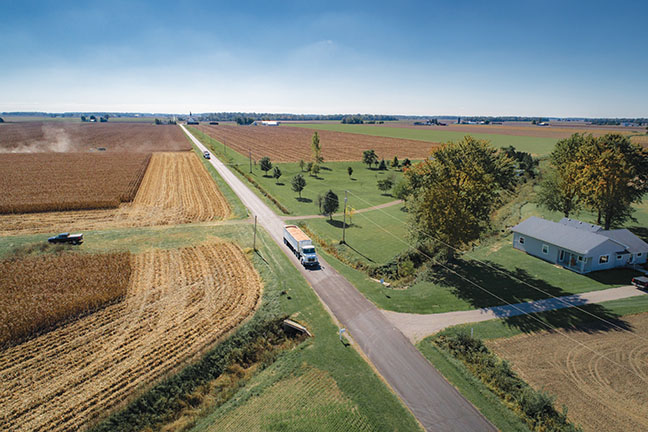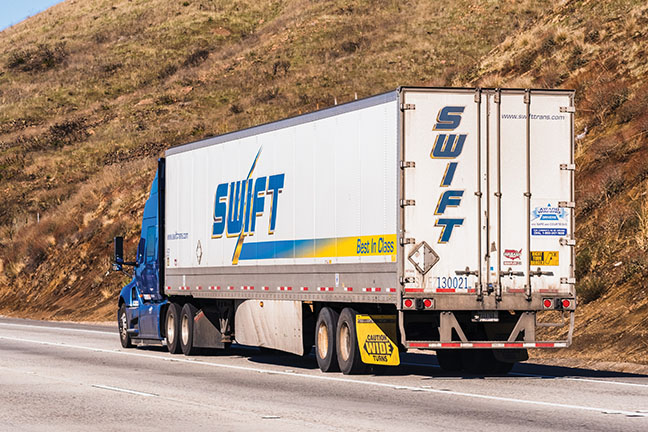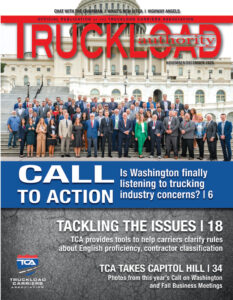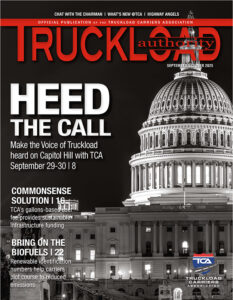While the aftermath of the general election and Joe Biden securing the presidency have taken the spotlight, trucking news continues to come out of the nation’s capital. This is highlighted by the release of the Federal Highway Administration’s updated version of its Jason’s Law truck parking survey that offered a picture of the status of what drivers say — based on a survey published in October — is the top concern among their ranks. Additionally, the Federal Motor Carrier Safety Administration has solidified a final rule clarifying agricultural commodity and livestock definitions in hours-of-service regulations, while the Commercial Vehicle Safety Alliance’s report on Brake Safety Week showed 12% of the 43,565 commercial motor vehicles inspected were placed out of service.
FHWA RELEASES UPDATED JASON’S LAW PARKING SURVEY
The Federal Highway Administration (FHWA) recently released an updated version of its Jason’s Law truck parking survey that offered a picture of the status of what drivers ranked — based on a survey published in October — as their top concern.
The report revealed new statistics but no real solutions.
According to the latest Jason’s Law survey, there are about 313,000 truck parking spaces across the nation, including 40,000 at public rest areas and 273,000 at private truck stops, an increase of 6% and 11% between 2014 and 2019, respectively.
The survey report found new shortages among the entire Interstate 95 corridor, Pacific corridors, and states surrounding the Chicago region, as well as other major freight corridors.
Not many new parking areas are being developed, the report said, because of challenges in planning and funding.
Some states reported fewer public spaces compared with 2014. Among them were Arizona, Colorado, Kentucky, Mississippi, New Jersey, New Mexico, South Dakota, Utah, and Washington state. On the other hand, Delaware, Florida, and Tennessee all showed increases in the number of parking spaces available.
Of the nearly 11,700 truck drivers participating in the survey — a 43% increase from the first Jason’s Law survey — 98% reported problems finding safe parking. Issues with truck parking were reported in every state and region.
According to the survey, the highest rate of parking issues was found along major freight corridors in states along Interstate 95, the Chicago region, and Interstate 5 in California.
Time frames when truck parking is most difficult to find include at night from 4 p.m. to 5 a.m., during the week Monday through Thursday, and in the colder months of October through February.
Among the other findings based on driver responses, it was noted that drivers need a variety of parking types; design is important in truck parking; safety and security is valued; public rest area closures present challenges; receivers should offer parking on site; and truck spaces need to be reserved for trucks.
State commercial motor vehicle (CMV) safety agencies show the states with the highest rate of unofficial or unauthorized truck parking are typically those with major freight-generating areas, major ports, and intermodal facilities.
California, Florida, Texas, and Illinois are among the states with high numbers of unauthorized parking, the report said.
According to the survey results, most of the unauthorized truck parking occurs on ramps (58%) and shoulders (34%), most often between 7 p.m. and 9 a.m.
CMV safety agency respondents reported that unauthorized truck parking is related to limited spaces and inclement weather, especially snowstorms in the Rocky Mountain states. Illegal parking also occurs when trucks park to stage while waiting for deliveries. Based on that information, FHWA claims dynamic messaging signs and other technologies are needed to send out information about parking availability.
Truck stop owners also participated in the 2019 Jason’s Law survey. According to the survey, more than 87% of identified truck parking is at private truck stops.
The average number of truck parking spaces per truck stop is 143 spaces. Truck stops reported being over 100% capacity overnight, on weekdays, and from May to October. Nearly three-quarters do not monitor parking. Those that do monitor spaces do so manually. More than three-quarters of truck stop respondents do not offer reservations, and 75% do not charge for parking. Of those that do charge for parking, 3% waive the fee for drivers who buy amenities or food.
Despite the need for parking and reports of operating over capacity, 79% of truck stop respondents said they do not plan to add more truck parking.
Jason’s Law is named in memory of professional truck driver Jason Rivenburg who was murdered for $7 while parked overnight at an abandoned gas station.
LIVESTOCK, AGRICULTURE DEFINITIONS PUBLISHED
The Federal Motor Carrier Safety Administration (FMCSA) has published a final rule clarifying agricultural commodities and livestock definitions in hours-of-service (HOS) regulations.
The agency said it had worked closely with the U.S. Department of Agriculture (USDA) on the rule in an effort to provide clarity for the nation’s farmers and commercial drivers.
“The agriculture industry is vital to our nation, and this new rule will provide clarity and offer additional flexibility to farmers and commercial drivers, while maintaining the highest level of safety,” said the U.S. Secretary of Transportation Elaine L. Chao.

Currently, during harvesting and planting seasons as determined by each state, drivers transporting agricultural commodities, including livestock, are exempt from HOS requirements from the source of the commodities to a location within a 150-air-mile radius from the source. The agricultural commodity rulemaking from FMCSA was prompted by indications that the current definition of these terms may not be understood or enforced consistently when determining whether the HOS exemption applies.
“I applaud Secretary Chao for recognizing these obstacles and working with USDA to come up with common sense definitions for agricultural commodities and livestock that meet both the needs of agricultural haulers and public safety — critical concerns for all of trucking,” said Secretary of Agriculture Sonny Perdue.
FMCSA published an advanced notice of proposed rulemaking in July 2019 to solicit feedback from the agriculture community. Based on a review of public comments, FMCSA published the new rule to clarify the meaning of these existing definitional terms to ensure that the HOS exemptions are utilized as Congress intended.
“Our nation’s farmers and agriculture haulers will benefit from this clarification of the rules and will be able to deliver their products in a safer and more efficient manner,” said FMCSA’s Deputy Administrator Wiley Deck. “These improved rules will help farmers move commodities and get food to our grocery stores. We have heard the concerns from our farmers and ag haulers and we’ve worked closely with USDA and the industry to provide regulatory clarity and craft this new rule.”
FMCSA said it is continuing to work closely with the USDA to eliminate confusion and further align the agencies’ interpretations of agricultural commodity definitions.
DOES CALIFORNIA VOTE EXEMPT TRUCKERS FROM AB5?
Proposition 22, which was designed to push back against AB5 in California for independent contractor drivers such as those at Uber or Lyft, passed comfortably in the November 3 general election.
The role of AB5 in trucking in California remains in the balance as a federal appeals court considers a challenge to an earlier and ongoing preliminary injunction that cited a 90s-era federal law — the Federal Aviation Administration Authorization Act — as effectively blocking the provisions of AB5 in the trucking sector. Oral arguments in the appeal were heard in early September.
The California proposition that was approved at the polls took ride-share drivers out of the state’s AB5 law. This should be a factor in whether the trucking industry remains exempt from it as well, according to a lawyer involved in key litigation.
In a letter to the court, the attorney for the California Trucking Association (CTA), which brought the original lawsuit, said the victory of Proposition 22 takes a further whack at the idea that AB5 is a law of “general applicability.” Mayer Brown Attorney Andrew Tauber said AB5 was never a law of general applicability, which would cover a broad swath of economic activity. The CTA’s argument is that it was always targeted toward trucking, as well as ridesharing, and is even more so with the success of Proposition 22.
Tauber noted that the original AB5 had several exemptions for various industries. That list of employee classifications grew with additional exemptions passed in September.
“Now AB5 has been amended yet again and once again rendered even less generally applicable than before,” Tauber wrote in the letter to the court. “After passage of Proposition 22, AB5 is not a generally applicable law — not even in the transportation industry, much less more broadly.”
According to published reports, in his arguments before the appeals court Tauber said the state of California — which is the CTA’s opponent in the case — had argued that AB5 can’t be preempted by F4A because it is a law of general applicability.
In his arguments before the court, Tauber had described that as a “false characterization.”
“AB5 is not a law of general applicability,” he argued. “It contains numerous exceptions for numerous industries and professions.” Further, he said, “it specifically targets the trucking industry.”
This was Tauber’s second letter to the court about the matter.
After the California legislature significantly widened the number of jobs that were performed by independent contractors that could be exempted from AB5, Tauber told the court that “truck drivers are notably absent from the long list of professions exempt from the ABC test under California law.” That omission, he said, helped make the argument that AB5 is a targeted piece of legislation and is not a law of general applicability.
MEDICAL EXAM RULING FAVORS KNIGHT-SWIFT
The Federal Motor Carrier Safety Administration (FMCSA) has granted Arizona-based Knight-Swift Transportation a temporary exemption from the requirement that motor carriers rely on motor vehicle records (MVRs) as proof of a driver’s medical qualifications as a condition of employment, according to a November 4 notice on the Federal Register. The exemption took effect December 4, 2020, and expires November 4, 2025.
Under the exemption, Knight-Swift can require newly hired commercial driver’s license (CDL) holders to undergo a complete medical examination; the company would rely on the MVR for drivers’ later annual reviews.
Knight-Swift first applied for the exemption March 8, 2016, citing the “prohibitive” cost of obtaining MVRs. According to a second application, submitted October 16, 2019, the 2016 application “languished for over three years” without being reviewed and processed.

FMCSA on December 23, 2019, published a notice of the application, requesting public comments.
According to the most recent Federal Register notice, FMCSA received three comments from individuals, all of which opposed granting the exemption. After reviewing the comments, along with the application, which included supporting data, FMCSA granted the exemption, noting that the agency believes that “allowing Knight-Swift to rely on its records of medical certificates for the first year of employment for newly hired drivers would not compromise safety or enforcement of the medical certification requirements for CDL holders.”
In its application, Knight-Swift provided data on a sample pool of 5,722 newly hired drivers with valid two-year medical cards. After undergoing the hiring process, 19% of the sample pool drivers were downgraded to a one-year certification and 2.1% were disqualified. Knight-Swift did not indicate whether it knew if these drivers (those holding a CDL) provided the new certification to the state driver licensing agencies (SDLAs) issuing their licenses. To ensure an equivalent level of safety, Knight-Swift proposes to include in the driver qualification file the newly hired driver’s medical examination report in lieu of obtaining a second MVR.
Under the temporary exemption, Knight-Swift is subject to the following terms and conditions:
- The carrier must maintain the initial MVR reviewed prior to hiring the driver showing the driver was medically certified by a health care professional on the agency’s National Registry of Certified Medical Examiners;
- The medical examiner’s report the company will rely upon for the first year of employment must be prepared by a health care professional on the agency’s National Registry of Certified Medical Examiners and be available for inspection by federal or state enforcement personnel during an investigation or compliance review; and
- Knight-Swift must obtain reliable proof that the new medical examiner’s certificate was provided by the driver to the SDLA and include such proof in the driver qualification file.
In addition, the carrier must provide a quarterly report to FMCSA about newly hired drivers whose two-year medical certificate is downgraded to a shorter term or are medically disqualified after completing the company-mandated medical exam. This report must include:
- Driver’s full name;
- CDL number and state of issuance;
- Medical examiner’s name and FMCSA-issued National Registry identification number for the examination recorded on the MVR prior to the Knight-Swift medical exam;
- Examination date and expiration date for the medical exam noted on the MVR;
- Knight-Swift medical examiner’s name and FMCSA-issued National Registry identification number; and
- Knight-Swift examination date and expiration date for the medical exam.
TANK HAULERS GET OK FOR PULSATING TAIL LIGHTS
Motor carriers hauling tank trailers can now install a red or amber brake-activated pulsating light on the rear of the trailers, according to a decision by the Federal Motor Carrier Safety Administration (FMCSA).
The pulsating light must be positioned in the upper center position or an upper dual outboard position and be used in addition to the steady-burning brake lights required by Federal Motor Carrier Safety Regulations (FMCSRs).
According to a notice on the Federal Register, FMCSA has granted a limited five-year exemption in response to a September 2019 application by National Tank Truck Carriers Inc. (NTTC), noting, “The agency has determined that granting the exemption would likely achieve a level of safety equivalent to or greater than the level of safety provided by the regulation.” The limited exemption will expire October 8, 2025.
NTTC is an association that includes more than 200 tank-truck companies responsible for transporting more than 80% of the volume in the tank-hauling industry. According to the Federal Register notice, most of NTTC’s members are regional, family-owned businesses that specialize in bulk transportation of hazardous products, such as petroleum products, chemicals, gases, and hazardous wastes. These companies also haul nonhazardous materials such as bulk foods and dry bulk products such as cement or plastic pellets.
In its application for an exemption from 49 CFR 393.25(e), NTTC contended the pulsating brake-activated light, used in conjunction with the required steady-burning light, will improve visibility and help prevent accidents.
“Rear-end crashes generally account for approximately 30% of all crashes. These types of crashes often result from a failure to respond (or delays in responding) to a stopped or decelerating lead vehicle. Data collected between 2010 and 2016 show that large trucks are consistently three times more likely than other vehicles to be struck in the rear in two-vehicle fatal crashes,” noted NTTC.
Additionally, NTTC cited a similar exemption granted by FMCSA to Groendyke Transport, Inc., based on real-world demonstrations of the pulsing lights’ effectiveness in reducing the frequency of rear-end collisions. NTTC also cited studies conducted by the National Highway Traffic Safety Administration on the issues of rear-end crashes, distracted driving, and braking signals.
In granting the current exemption, FMCSA noted that while flashing, rotating, or pulsating red lights are usually only allowed on emergency vehicles, these vehicles use high-intensity lights that are visible on all sides of the vehicle, while the pulsating brake lights requested by NTTC are visible only from the rear of the vehicle, and only when the vehicle’s brakes have been activated. In addition, FMCSA said, the requested lights are similar in intensity and flash rate to rear-hazard lights currently allowed by FMCSRs.
The Truckload Carriers Association filed comments with FMCSA in support of both the NTTC and Groendyke exemptions.
FMCSA SEEKS OPINIONS ON AUTOMATED DRIVING SYSTEMS
The Federal Motor Carrier Safety Administration (FMCSA) is seeking public input on a survey questionnaire, Trucking Fleet Concept of Operations (CONOPS) for Managing Mixed Fleets, designed to collect opinions of automated driving systems (ADS) from industry professionals both before and after hands-on demonstrations with the technologies.
The agency plans to use the survey to collect opinions from about 2,000 commercial vehicle drivers, fleet managers, industry engineers, vehicle-sales personnel, researchers, and state and federal government personnel at four roadshows. The roadshows will take place in conjunction with large conferences, such as the Technology Maintenance Council’s annual meeting, the North American Commercial Vehicle Show, the SAE COMVEC digital summit and the Automated Vehicle Symposium.
Phase 1 of the study will be conducted before the roadshows to provide baseline opinions of ADS technologies; Phase 2 will consist of opinions gathered after participants take part in hands-on demonstrations of the technologies at the roadshows.
“Although ADS-equipped trucks hold the promise of increased safety, productivity, and efficiency, it is not clear how these vehicles should be integrated into fleet operations with conventional trucks for mixed-fleet operations,” the notice reads. “Existing stakeholders in the road freight ecosystem (primarily for-hire and private truck fleets, but also shippers, brokers, truck manufacturers, and service and maintenance providers) do not have a clear picture of how they will implement ADS in their daily operations.”
According to the notice, FMCSA hopes to use the program to help ADS technology gain traction in the nation’s trucking industry through hands-on demonstrations. Through these demonstrations, the agency hopes to familiarize industry insiders and the general public with ADS technology; collect participants’ opinions and perception of ADS; and use the data collected to make sure the resulting concept of operations covers major industry concerns.
FMCSA is seeking comments on various aspects of the information-collection program, including the following:
- Whether the proposed collection is necessary for the performance of FMCSA’s functions;
- The accuracy of the estimated burden;
- Ways for FMCSA to enhance the quality, usefulness, and clarity of the collected information; and
- Ways that the burden could be minimized without reducing the quality of the collected information.
TRUCKING FIRM OWNER CHARGED FOR FALSE STATEMENTS
Tony Kirik, 39, of Rochester, New York, is facing criminal charges for allegedly making false statements to the Federal Motor Carrier Safety Administration (FMCSA) and the U.S. Department of Transportation and conspiring to do the same. The charges carry a maximum penalty of five years in prison and a $250,000 fine.
Assistant U.S. Attorney John J. Field, who is handling the case, stated that according to the criminal complaint, Kirik owned and controlled a trucking business called Dallas Logistics. The company was put in the name of a nominee owner to conceal the fact that it was affiliated with another trucking company, Orange Transportation, that Kirik also controlled.
Orange Transportation had received a negative rating from the Department of Transportation, and that negative rating would have been applied to Dallas Logistics had the true relationship between the two entities been disclosed to the FMCSA. To prevent the government from learning that the two entities were affiliated, Kirik directed his employees to create and present false documents and representations to the FMCSA.
The defendant made an initial appearance in late November before U.S. Magistrate Judge Marian W. Payson and was released.
The criminal complaint is the result of an investigation by special agents of the Department of Transportation, Office of Inspector General. The fact that a defendant has been charged with a crime is merely an accusation and the defendant is presumed innocent until and unless proven guilty.
HIGHWAY DESIGN STANDARDS PROPOSED
The Federal Highway Administration (FHWA) has published a Notice of Proposed Rulemaking (NPRM) to allow state departments of transportation more flexibility with design standards to repair the nation’s freeways and interstate highways.

“The FHWA proposes to provide regulatory relief to states to address the immediate repair needs of our nation’s roadways without compromising safety and efficiency,” Federal Highway Administrator Nicole R. Nason said.
The rule would allow states to develop design standards for resurfacing, restoration, and rehabilitation projects — commonly known as RRR — for freeways, including those on the interstate system, which has been a longstanding practice for non-freeway projects.
Consistent with federal law, RRR standards would be required to preserve and extend the service life of the existing roads and enhance highway safety. This change would allow states to develop RRR freeway projects using a performance-based, flexible approach.
The RRR standards developed by states would be subject to FHWA approval. FHWA would continue to work with state departments of transportation as they develop RRR design standards that integrate safety and cost-effectiveness.
The rule also proposes to incorporate the latest versions of design standards and standard specifications that have been previously adopted.
The Truckload Authority News Staff, comprised of award winning journalists and graphic artists, produces content for Truckload Authority, working in cooperation with the Truckload Carriers Association staff. Truckload Authority aims to keep TCA members abreast on the latest trends in the trucking industry as well as articles that feature TCA member executives and drivers. The Truckload Authority staff is based in Little Rock, Arkansas.













